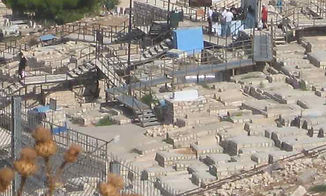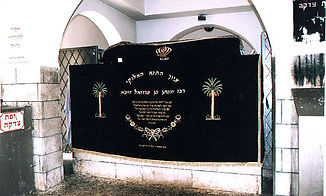Holy Prayer Sites
Tzidkat Rashbi has two full day Yeshivos Kollellim studying Torah at Kever Rochel and in Amukah. Prayers are recited daily at the Holy Sites which are in the vicinity of our two learning centers.
The practice of praying at the grave-site of the Tzaddik is an ancient Jewish concept and custom.
“Even after death, the tzaddikim are called living.” (Berachot 18a). Chassidim and Anchei Ma’ase, who are particular with speech, use the words “Bet-HaChaim”, “Place of the living” rather than the word cemetery. It appears that in Tzfat the name Bet-HaChaim is really appropriate since there’s no place in Tzfat as lively as the cemetery!
The practice of praying at the gravesite of the Tzaddik is an ancient Jewish concept and custom. We see in the Torah that Yaakov buried Rachel on the road outside of Beit Lechem because he saw with prophesy that when the Jews would be exiled to Babylon, they would pass that spot and have the opportunity to pray there, and in the merit of the Matriarch Rachel, Hashem would promise to bring the Jews back from exile.
People from around the world place their prayers on the tomb of Rabbi Shimon bar Yochai in Meron, Rabbi Yonatan ben Uziel in Amukah, Kever Rachel, and many other places or email them to Tzidkat Rashbi as a messenger to place them at the holy places.
Hundreds of people visit Rabbi Shimon's kever daily seeking solutions for their problems or just looking for a rejuvenation of their spirituality. He was a tanna and the author of the holy Zohar.
Rachel, the beloved wife of the Patriarch Jacob died in childbirth. For millennia, Jews have made pilgrimages to Rachel’s Tomb, considered the third holiest shrine in the Land of Israel.
One of the four holiest cities in Judaism is Safed, a beautiful city in the Galilee that has a rich history dating back to ancient times.
Much of life in the Jewish areas of Safed revolved around the synagogue and for this reason there are many ancient synagogues within the city.
The cemetery attracts more than 700,000 visitors each year – who come to make a pilgrimage to the graves of saints, rabbis, and central figures in the history of the Jewish people.
Rabbi Meir Baal Haness is buried on the shores of Lake Kinneret, only a short distance from the city of Tiberius.
Praying at the resting place of Rabbi Yonatan ben Uziel is known to draw down blessing in the search for a soulmate.
Tiberius, which sits on Lake Kinneret, is considered one of the four holy cities in the Jewish faith. Tiberius was the main center of Jewish learning in the Land of Israel.
Rabbi Leib “Baal Ha’yissurim” — “The Master of Suffering” or “The Afflicted One”– was an outstanding scholar and G-d-fearing man, a major disciple of Rabbi Shneur Zalman, the first Rebbe of Chabad.
◄
1 / 1
►










